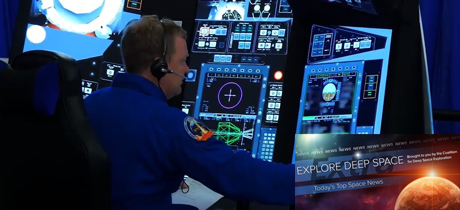In Today’s Deep Space Extra… NASA and its Commercial Crew Program partners face scrutiny over test flight schedules. Far from Earth artificial intelligence could become an essential tool for exploration and discovery. A new European solid rocket motor clears a test milestone.
Human Space Exploration
When will commercial crew launch?
Coalition Member in the News – Boeing
The Space Review (7/17): NASA’s Commercial Crew Program is facing increased external scrutiny as previously timelined efforts to certify Boeing’s CST-100 Starliner and SpaceX’s Dragon 2 for the transportation of NASA and other astronauts to and from the International Space Station by early 2019 come into doubt. Russia’s Soyuz has furnished the only transportation to and from the six person orbiting lab since NASA retired its shuttle fleet in mid-2011. NASA’s access to Soyuz seats could lapse prior to the certifications, raising a larger concern over whether U.S. staffing of the ISS might be interrupted.
Mining Moon ice: Prospecting plans starting to take shape
Space.com (7/13): Scientists, engineers and some from the mining industry are joining to discuss how they might mine the crater recesses of the Moon’s poles for ice. Frozen water is a resource that could be processed by future space explorers for oxygen for life support and oxygen and hydrogen for rocket propellants that could find commercial buyers as far as low Earth orbit. The Colorado School of Mines hosted a recent Space Resources Roundtable to discuss the prospects.
MIT’s ‘Orbit Weaver’ turns astronauts into spiders
Motherboard (7/16): Inspired by the motion of spiders, MIT’s Orbit Weaver device is designed to help astronauts move while weightless. The hand held tool flings a magnet to a structural surface to pull floating astronauts close. Orbit Weaver has yet to be tested in space.
Space Science
Ars Technica (7/16): As space faring nations explore further and further, an emerging artificial intelligence capability will become more crucial to making and understanding significant discoveries. Two NASA rovers on Mars, Opportunity and Curiosity, have helped to establish AI capabilities. NASA’s Mars 2020 rover and the European Space Agency’s future ExoMars rover are expected to advance them.
Hawaiian asteroid-warning telescope passes key test
Space.com (7/16): The Asteroid Terrestrial-impact Last Alert System (ATLAS) in Hawaii has demonstrated a capability to detect a small fast moving space rock just hours before it slammed into the Earth’s atmosphere. The June 2 incident involved 2018 LA, an asteroid measuring about six feet across. “This is a great test of the system,” noted the observatory’s principal investigator. Similar observations of larger, more dangerous asteroids could lead to a lifesaving evacuation order for the predicted impact site.
Trio of observatories reveal rare double asteroid
Spaceflightinsider.com (7/16): The rare double equal mass Near Earth Asteroid asteroid pair, 2017 Yes, was discovered last December by a Moroccan observatory, though few characteristics were discernable. In June, radio telescopes in Puerto Rico, West Virginia and California were able to join forces to confirm 2017 Yes is indeed two objects, each about 3,000 feet long and orbiting one another.
Other News
How a small Scottish town aims to transform commercial spaceflight
Coalition Member in the News – Lockheed Martin
Space News (7/16): Sutherland in the rugged north of Scotland was named Sunday at the start of the Farnborough Air Show as the U.K.’s pick for a vertical launch complex, the country’s first. Lockheed Martin will lead the lengthy development effort with other commercial partners, all financed through a $40 million government grant. Britain hopes to couple its first launch site with a domestic talent pool and small satellite assembly expertise. The launch site will have access to polar and near polar orbits. “…we only expect appetite for British launch capability to grow,” writes Antony Phillipson the U.K.’s trade commissioner for North America.
Powerful new European solid-fueled rocket motor aces first test-firing
Spaceflightnow.com (7/16): A European solid rocket booster that is to serve as a first stage strap on for the new Ariane 6 rocket and first stage for the Vega C light lift rocket passed a development milestone on Monday with a 135 second firing at the European spaceport in French New Guinea. The Vega C is to begin operations late next year, the Ariane 6 in 2020.

